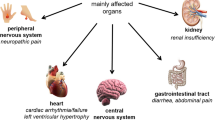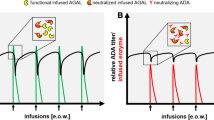Abstract
Summary: Fabry disease is an X-linked glycosphingolipid storage disorder caused by a deficiency of α-galactosidase A. Affected patients experience debilitating neuropathic pain and have premature mortality due to renal failure, cardiovascular disease or cerebrovascular complications. The disease may be X-linked dominant, since most females heterozygous for Fabry disease are affected clinically. We evaluated the safety, efficacy and pharmacokinetics of agalsidase alfa (Replagal) administered intravenously to female patients with Fabry disease in an open-label, single-centre study. Fifteen severely affected patients received agalsidase alfa at 0.2 mg/kg every other week for up to 55 weeks. Agalsidase alfa was safe and well-tolerated in female patients. None of the patients developed antibodies or experienced an infusion reaction to agalsidase alfa. The pharmacokinetic profile of agalsidase alfa in female patients is comparable to the pharmacokinetics of agalsidase alfa in male patients. Mean urine sediment and plasma Gb3 levels decreased from baseline at 13, 27 and 41 weeks. A significant decrease in left ventricular mass from baseline was seen at weeks 27 (p = 0.003) and 41 (p = 0.039), and a significant reduction in QRS durations was seen at week 27 (p = 0.007). Furthermore, there was a significant improvement in quality of life. Renal function did not deteriorate in these 15 female patients over the 13- to 41-week period of observation. We conclude that enzyme replacement therapy with agalsidase alfa was safe and effective in female patients heterozygous for Fabry disease.
Similar content being viewed by others
REFERENCES
Brady RO, Gal AE, Bradley RM, et al (1967) Enzymatic defect in Fabry's disease. N Engl J Med 276: 1163–1167.
Casale PN, Devereux RB, Milner M, et al (1986) Value of echocardiographic measurement of left ventricular mass in predicting cardiovascular morbid events in hypertensive men. Ann Intern Med 105(2): 173–178.
Cohen J (1977) Statistical Power Analysis for the Behavioral Sciences. New York: Academic Press.
Cornish-Bowden A (1995) Fundamentals of Enzyme Kinetics, 2nd ed. London: Portland Press.
Desnick RJ, Ionnou YA, Eng CM (2001) c-Galactosidase A deficiency: Fabry disease. In: Scriver CR, Beaudet AL, Sly WS, Valle D, eds.; Childs B, Kinzler KW, Vogelstein B, assoc. eds. The Metabolic and Molecular Bases of Inherited Disease, 8th edn. New York: McGraw-Hill, 3733–3774.
deVeber GA, Schwarting GA, Kolodny EH, et al (1992) Fabry disease: immunocytochemical characterization of neuronal involvement. Ann Neurol 31(4): 409-415.
Donati D, Novario R, Gastaldi L (1987) Natural history and treatment of uremia secondary to Fabry's disease: a European experience. Nephron 46(4): 353–359.
Elert U, Bellach BM (1999) Der SF-36 im Bundesgesundheitssurvey Beschreibung einer aktuellen Normstichprobe. Gesundheitswesen 61. Sonderheft 2.
Gold KF, Pastores GM, Botteman MF, et al (2002) Quality of life of patients with Fabry disease. Qual Life Res 11: 317–327.
Gosling JP (2000) Immunoassays. Oxford: Oxford University Press.
Kahn P (1973) Anderson Fabry disease: A histopathological study of three cases with observations on the mechanism of production of pain. J Neurol Neurosurg Psychiatry 36: 1053–1062.
Kampmann C, Baehner F, Ries M, et al (2002a) Cardiac involvement in Anderson Fabry disease. J Am Soc Nephrol 13(Suppl 2): S147–149.
Kampmann C, Baehner F, Whybra C, et al (2002b) Cardiac manifestations of Anderson-Fabry disease in heterozygous females. J Am Coll Cardiol 40(9): 1668–1674.
Kaye EM, Kolodny EH, Logigian EL, et al (1988) Nervous system involvement in Fabry's disease: clinicopathological and biochemical correlation. Ann Neurol 23(5): 505-509.
Koren MJ, Devereux RB, Casale PN, et al (1991) Relation of left ventricular mass and geometry to morbidity and mortality in uncomplicated essential hypertension. Ann Intern Med 114(5): 345–352.
Kornfeld S, Mellman 1 (1989) The biogenesis of lysosomes. Annu Rev Cell Biol 5: 483-525.
MacDermot KD, Holmes A, Miners AH (2001) Anderson-Fabry disease: clinical manifestations and impact of disease in a cohort of 60 obligate carrier females. J Med Genet 38(11): 769-775.
Samsa G, Edelman D, Rothman M, et al (1999) Determining clinically important differences in health status measures: A general approach with illustration using the Health Utilities Index Mark II. Pharmacoeconomics 15(2): 141-155.
Schiffmann R, Murray GJ, Treco D (2000) Infusion of alpha-galactosidase A reduces tissue globotriaosylceramide storage in patients with Fabry disease. Proc Nati Acad Sci USA 97(1): 365–370.
Schiffmann R, Kopp JB, Austin HA 3rd (2001) Enzyme replacement therapy in Fabry disease: a randomized controlled trial. J Am Med Assoc 285(21): 2743–2749.
Talamo J, Frater A, Gallivan S, et al (1997) Use of the short form 36 (SF36) for health status measurement in rheumatoid arthritis. Br J Rheumatol 36: 463–469.
Ware J (1993) SF-36 Health Survey: Manual and Interpretation Guide. Boston, MA: The Health Institute.
Ware J (1994) SF-36 Physical and Mental Health Summary Scales: A User's Manual. Boston, MA: The Health Institute.
Whybra C, Wendrich K, Ries M, et al (2001a) Clinical manifestation in female Fabry disease patients. Contrib Nephrol 136: 245–250.
Whybra C, Kampmann C, Willers I, et al (2001b) Anderson Fabry disease: clinical manifestations of disease in female heterozygotes. J Inherit Metab Dis 24(7): 715–724.
Author information
Authors and Affiliations
Corresponding author
Rights and permissions
About this article
Cite this article
Baehner, F., Kampmann, C., Whybra, C. et al. Enzyme replacement therapy in heterozygous females with Fabry disease: Results of a phase IIIB study. J Inherit Metab Dis 26, 617–627 (2003). https://doi.org/10.1023/B:BOLI.0000005658.14563.77
Issue Date:
DOI: https://doi.org/10.1023/B:BOLI.0000005658.14563.77




